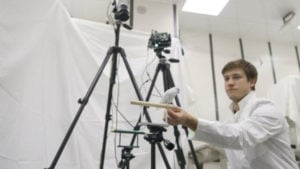
At first glance, Assistant Professor of Mechanical Engineering David Lentink’s lab appears part machine shop and part aerospace development lab. The lab contains a small wind tunnel that emerges from one side of the room and recedes into the opposite wall. However, unlike other wind tunnels, this one has been specifically designed to study the flight of birds.
Lentink and his assistant Mark Deetjen, a third-year mechanical engineering Ph.D. candidate, are developing a new method to map dynamic surfaces in order to discover key features of bird’s wings, which could be applied to the study of any flight movement. According to Lentink, this could have implications in the growing drone market.
Lentink has been fascinated by bird flight for the majority of his career. Even pigeons, which he described to The Daily as “not accomplished fliers,” easily maneuver through tricky air currents created by wind and towers in large cities. By comparison, laws ban drones from flying in similar conditions because of the risk to pedestrians and windows. Through his research, Lentink hopes to understand what birds have that drones do not.
In past studies, researchers projected an array of dots or colors onto birds while filming their flight. Deetjen instead uses a type of barcode that provides data faster. A series of projectors and cameras flash and record this grid onto the birds’ bodies as they move, sometimes as many as 3,200 times per second. This allows the researchers to create computerized models of the wings during flight.
Lentink uses the system to compare and contrast the designs of birds’ wings and those of airplanes.
According to Lentink, aeronautical engineers generally build static airplane wings to function best at their cruising speed. However, birds can change the shape of their wings to accommodate a variety of flight velocities and wind patterns, granting them stability that airplanes may never obtain.
Furthermore, while airplanes often have to reach speeds of over 150 miles per hour in order to take off, birds have developed an entirely different mechanism that allows them to rise faster. They tilt their wings up to 60 degrees from the horizontal, leap into the air and beat their wings rapidly. Through this process, birds can support their body weight using pressure drag rather than using lift as airplanes do. Once in the air, birds can shift their wings to permit forward flight.
This radical angling of the bird’s wings shocked Lentink, who initially believed that he had obtained bad data. Airplanes stall when their wings tilt above 15 degrees from the horizontal, and insects rarely tilt above 30. However, it appears that this strategy allows for a fast and efficient takeoff for birds.
According to Lentink, the new technology and its findings could change the drone market. Currently, the best drone is a “hummingbird,” which hovers well but struggles to fly forward. This machine weighs about five times as much as a natural hummingbird. In addition, most drones cannot cope well in varying weather conditions, and turbulence and clutter can be fatal for drones in cities, according to Lentink. Thus, studying the flight of birds may help researchers create more effective designs for drones in rough conditions.
For his studies, Lentink mainly uses Stanford-owned parrotlets, the second smallest birds in the world.
“They are very fast learners,” Lentink said.
One of the most intelligent birds in the group, Ferrari, can learn new behavior after just a single round of positive reinforcement. Lentink uses a clicker each time the bird exhibits a desired behavior, and then gives it a seed.
“The others are quick, too,” Lentink said. “But not as fast as an Italian sports car.”
Lentink believes there is much work to be done before scientists mechanize machines to fly like Ferrari. Understanding how birds orient and use their wings provides the first insight into designing smooth-flying urban machines. While Lentink doesn’t see bird technology entering the aerospace industry for at least five to 10 years, he remains hopeful that scientists will one day be able to replicate bird flight.
Contact Josh Kazdan at jkazdan ‘at’ stanford.edu.